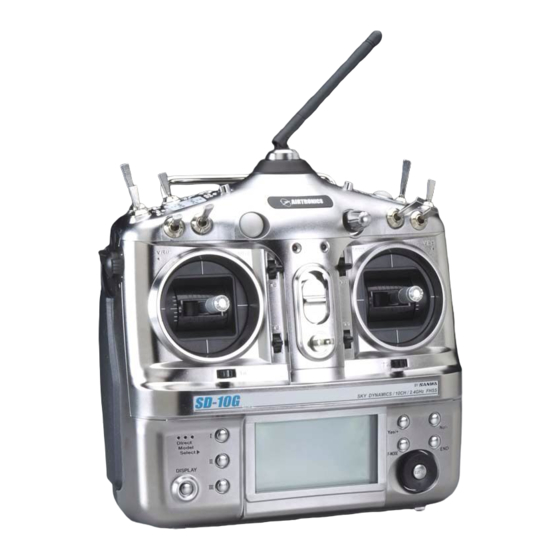AIRTRONICS SD-10G Aero Manuel - Page 5
Parcourez en ligne ou téléchargez le pdf Manuel pour {nom_de_la_catégorie} AIRTRONICS SD-10G Aero. AIRTRONICS SD-10G Aero 16 pages. 2.4ghz fhss-3 radio control system
Également pour AIRTRONICS SD-10G Aero : Manuel d'installation rapide (8 pages), Manuel de démarrage rapide (5 pages)

glossary of terms
FH3 Modulation: Frequency Hopping 3rd generation FHSS technology. FH3 Modulation is used in the Airtronics SD-10G
2.4GHz FHSS-3 transmitter and matching 92104 10-Channel receiver.
FHSS: Frequency Hopping Spread Spectrum. FHSS is a modulation type which transmits data across the entire frequency
spectrum by transmitting data on different channels at an extremely fast interval.
Flap Freeze Point: Used with sailplanes, the Flap Freeze Point function allows you to set a predetermined amount of flap
deflection, based on flap control stick position, then variably control the remainder of flap travel, using the flap control stick. An
audible tone can be programmed to indicate when the Flap Freeze Point turns ON and OFF.
Flaperons: Flaperons is a mix of flaps and ailerons, allowing you to use the ailerons as flaps if your model does not feature
separate flaps. When Activated, both ailerons are moved down at the same time to provide the function of flaps, while still providing
aileron roll control.
Flight Modes: Flight Modes allow you to change the flying characteristics of your model with the flip of a switch. Each Model
Type (AERO, GLID, and HELI) feature five independently programmable Flight Modes. Within these Flight Modes is where the
core of the model programming takes place. Features such as Dual Rate, Exponential, Throttle Curves, Pitch Curves, Mixing,
Compensation Mixing, and much more can be individually programmed to each of the five flight Modes. Each Flight Mode can
then be assigned to a switch position so that they can be turned ON and OFF during flight. For example, you can have one Flight
Mode for basic flying and a second Flight Mode for aerobatic flying. Flip the Flight Mode switch from 'Basic' to 'Aerobatic' and
your model is now programmed with all of your 'Aerobatic' Flight Mode programming.
Flight Mode Key: Allows you to cycle through the five different Flight Modes while in the Flight Mode Programming menu.
Governor: A Governor is an electronic device used on glow-powered helicopters, that, coupled with a high-speed servo, is used
to control a helicopter's rotor head speed.
Gyro: A Gyro is an electronic device, that coupled with a high-speed servo linked to the tail rotor control arm, is used to stabilize
a helicopter's yaw axis.
Hovering Throttle: The Hovering Throttle function allows you to adjust specific Throttle Curve Points to fine-tune the Throttle
Curve at any throttle control stick position, not just the hovering position. The Hovering Throttle function is controlled by the
Hovering Throttle Trim Switch (T5).
Hovering Pitch: The Hovering Pitch function allows you to adjust specific Pitch Curve Points to fine-tune the Pitch Curve at any
throttle control stick position, not just the hovering position. The Hovering Pitch function is controlled by the Hovering Pitch Trim
Switch (T6).
Inhibit: To deactivate or turn OFF a particular function.
Integral Timer: The Integral timer is a Count Up timer that displays the time that the SD-10G transmitter has been turned ON
(either via the Power switch or the Display key) since the last time the Integral timer was Reset. The Integral timer is not
model-specific, so, for example, it is good to use as an indicator to chart the usage time between battery charges.
Idle Down: The Idle Down function allows you to set a specific position that the throttle servo will move to. The Idle Down
function is similar to the Throttle Cut function, however, whereas the Throttle Cut function is designed to be used to shut down
your engine, the Idle Down function is designed to be used to set your engine to a specific idle speed that is different from the idle
speed provided when the throttle control stick is pulled all the way back, yet still maintain the full range of throttle travel.
LCD Display: Liquid Crystal Display. The LCD Display displays all of the transmitter programming and related information.
The LCD Display contrast can be customized.
Linear Channel Programming: Allows you to program servo travel directly in relation with the amount of control stick travel for
the entire range of deflection.
Low Power Mode: The Low Power Mode function lowers the transmitter's RF output level to check radio signal reception (Range
Check). Use this function to check radio signal reception on the ground, prior to flight. The radio control system should be Range
Checked prior to the day's first flight and prior to the first flight after a hard landing or after a repair. This will ensure that the
transmitter and receiver are communicating properly prior to flight.
Memory Expansion Card: The Memory Expansion Card allows you to store up to 40 models (20 in the SD-10G transmitter
and 20 on the Memory Expansion Card). The Memory Expansion Card can be removed and installed into a different SD-10G
transmitter, so that model-specific programming data can be shared with fellow SD-10G transmitter owners in the field. When
the Memory Expansion Card is installed and Initialized, it is treated as an extension of the SD-10G transmitter's internal model
memory, therefore, model-specific programming data can be created, copied, deleted, etc., directly through the various System
menu selections.
Memory Expansion Card Slot: Holds the Memory Expansion Card (available separately).
Page 197
